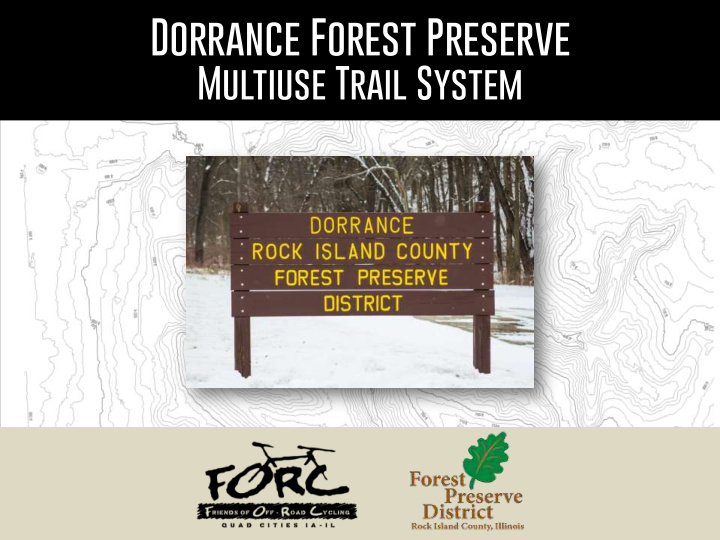



Dorrance Forest Preserve Multiuse Trail System
What is FO RC? • Friends of Off-Road Cycling [FORC] • Nonprofit, trail development, MTB education, advocacy, & community • Building trail since 1997 • Have built/maintain +30 miles of singletrack trail in the QC area at 6 locations • Contribute +1000 hours of maintenance and upkeep annually to local trails • +200 members and growing • More info: www.qcforc.org
Project Goals • Develop a system of multiuse, human powered, trails at Dorrance Forest Preserve • Improve and diversify recreational opportunities in Port Byron and northern Rock Island County • Enhance Port Byron as a recreation destination
The Many Benefits of Trails Quality of Life – Encourage and enable opportunities for exercise – Regular exercise strongly linked to positive physical/mental health – Reconnect to nature (spiritual) Strengthen Community – Encouraging opportunities to meet and interact with neighbors – Reducing crime and illegal activity through regular use and high visibility of users – Providing affordable exercise and recreational opportunities within the community Economic – Grow local economy by attracting visitors (eco-tourism) and residents – Property close to trails typically increases in value (1-6%) – 2002 National Association of Home Builders survey concluded access to hiking, biking, and walking trails are a priority for 40% of home buyers Environmental Stewardship & Conservation – Strong connections to nature foster respect and stewardship of the environment – Providing access to “outdoor” classrooms for learning and community service Family/Kids – Provide “quality time” with family in a safe and close to home environment – Creating positive life-long experiences
Elements for Project Success Meet Funding Targets – Bridges and structures necessary for trails in steep terrain – Signage necessary for positive user experience and resource protection Local Volunteers & Community Involvement – Core group needed for long term maintenance and short term construction goals
Trail Design Characteristics Sustainable Design – Low environmental impact, low maintenance, long lasting Natural Surface Singletrack – 12” to 24” trail width Multiuse – Hiking, mountain biking, trail running, cross country skiing, and other human powered recreation
Trail Design Characteristics Stacked Loop Layout – Easy to navigate, gives users different difficulty options, increased appeal for those seeking more challenging & diverse trail experience
Park Features Large Area – 70 acres of land available for trail development – Terrain ideal for singletrack trail Additional Amenities – Bathrooms, parking, playground, picnic shelter, ball diamonds Upland Forest Ecosystem – Hardwood trees, wildflowers, steep terrain, numerous streams, diverse wildlife Ideal Location – Easy access from major highway (IL- 84) and Great River Trail – Close proximity to downtown Port Byron
101 Trail - 1.4 mi • Wider trail (18- 24”) • Gentle grades (~5%) • Smooth surface • Bypass option for shorter route options • Well suited for short nature walks and beginner mountain bikers, cross country skiing
201 Trail - 1.0 mi • Narrower tread (18”) • Moderate grades (<10%) • Optional challenging trail features • Some trail surface roughness • More demanding (physically & skill wise) • Suitable for seasoned hikers, mountain bikers, and trail runners
301 Trail - 1.1 mi • Narrow tread (12- 18”) • Steeper grades (10-15%) • Challenging trail segments requiring more physical exertion • More elevation change • Difficult natural obstacles (some unavoidable) • Rough, less developed, trail surface • Well suited for those looking for a challenge (MTB) or a primitive trail experience (hiking & running)
Trail Structures: Bridges Primitive – Utilize native materials, short spans, rough & natural appearance, low cost, high effort Simple Bridge – Short spans, simple construction, dimensional lumber, moderate cost, moderate effort Engineered Bridge – Spans over 20’, significant foundation, design required, high cost, high effort
Trail Structures: Boardwalks • Boardwalks used to span persistent wet areas • Usually needed in low areas and near water sources • Keeps users out of the mud • Improves: trail sustainability, user experience, and water quality
Trail Signage Kiosk – Trail rules, maps, and announcements Trail Closure Sign – Protect trail from damage during muddy conditions Flex Post Trail Markers – Trail information – Trail difficulty – Way finding
Timeline / Schedule Green Trail (101) – 8 months (2016-17) Blue Trail (201) – 5 months (2017-18) Black Trail (301) – 6 months (2018-19) Expected Completion Date 2019
$ Volunteer Value • Typical cost per mile of professionally built trail is +$15,000 in steep terrain • Est. $52,500 value for 3.5 miles of trail at Dorrance • Volunteer hours expected for project completion: 2500 hours
Project Expenses Trail Structures – Bridges & Boardwalks ($3800) Signage – Informational, Guidance, & Regulatory ($1700) Tools – Hand tools for volunteers and misc. supplies ($500) Total: $6000
How Can Port Byron Help? • Work with FORC to recruit C ur r ent Funding volunteers for trail construction and spread word about project • Assist with funding for signage & $1,500 structures $3,000 – willing to match Port Byron contribution up to $1,500 $1500 – A $1500 contribution from Port Byron would fully fund this project RICFPD River Action (Pending) Unfunded
More Project Info More information about this project will be made available through FORC’s website: • General Trail Information: http://www.qcforc.org/content.php?221- Dorrance-Forest-Preserve • Volunteer Work Day Announcements & General Trail Discussion: http://www.qcforc.org/forumdisplay.php?35-Dorrance-Forest- Preserve-DFP Announcements will also be posted to FORC’s Facebook page: https://www.facebook.com/QCFORC
Recommend
More recommend